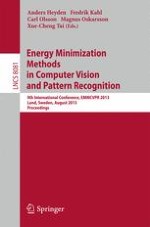2013 | Buch
Energy Minimization Methods in Computer Vision and Pattern Recognition
9th International Conference, EMMCVPR 2013, Lund, Sweden, August 19-21, 2013. Proceedings
herausgegeben von: Anders Heyden, Fredrik Kahl, Carl Olsson, Magnus Oskarsson, Xue-Cheng Tai
Verlag: Springer Berlin Heidelberg
Buchreihe : Lecture Notes in Computer Science
